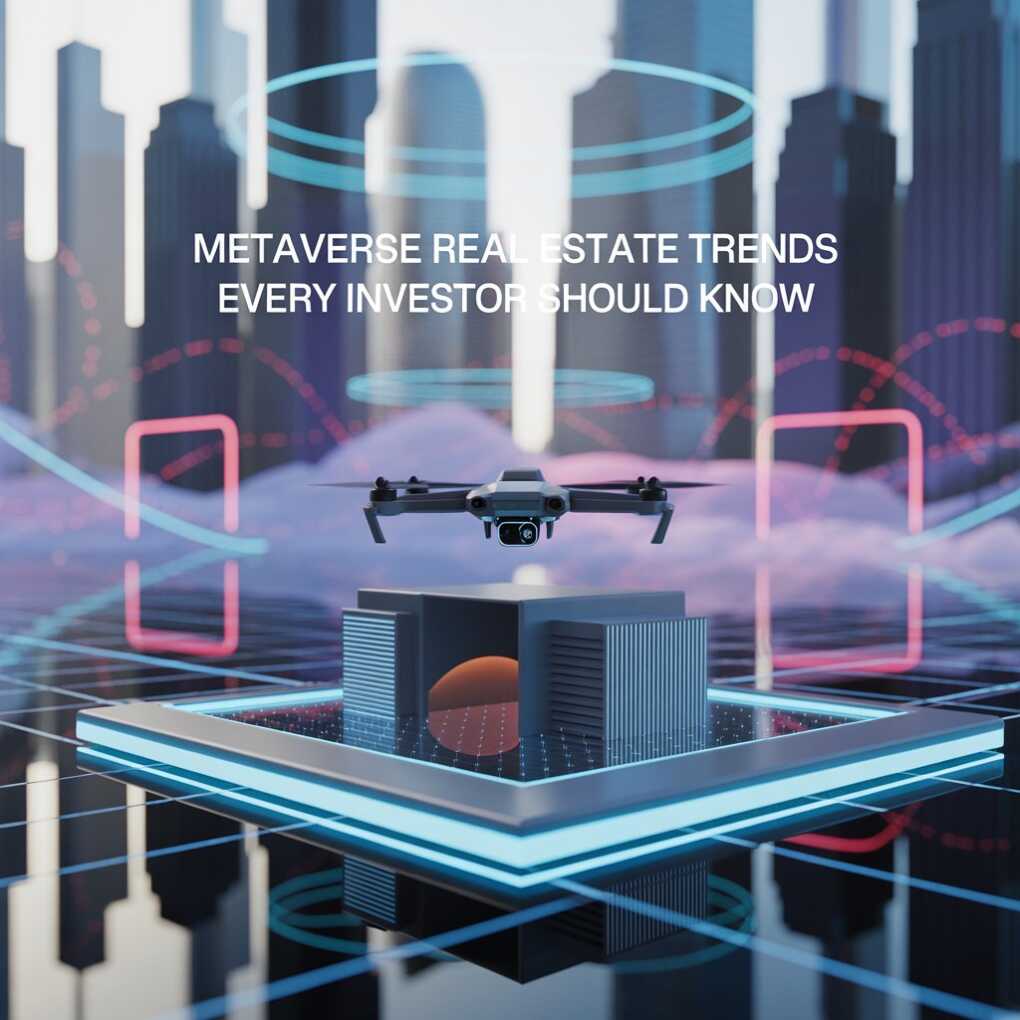You’re no stranger to headlines about virtual land grabbing, but separating hype from real market signals is another story.
Before you scout pixel parcels or sign smart deeds, you’ll need a clear view of legal frameworks, token standards, and community growth patterns.
Start by skimming this concise guide on real estate in the metaverse; it grounds the flashy narratives in practical facts you can actually verify before opening your wallet.

Market Growth Acceleration
The metaverse property space is no side show; projections indicate expansion from 4.12 billion dollars in 2025 to 67.40 billion by 2034, compounding at an eye-popping 36.55 percent.
Why The Numbers Matter
Rapid growth attracts capital, developers, and regulators, creating a feedback loop where fresh liquidity finances bigger experiences, driving still more participants into virtual precincts worldwide.
Regional Hotspots
North America retains early leadership thanks to tech infrastructure, yet Asia-Pacific is sprinting ahead, encouraged by governmental digital-economy incentives and mobile-first populations hungry for immersive platforms.
Segment Leaders
Buying land commands forty-seven percent of 2024 turnover, but selling is forecast to outpace with forty percent CAGR, illustrating an increasingly fluid secondary marketplace for pixels.
Developer Dominance
Virtual real-estate developers captured sixty percent share, proving that professional builders—rather than casual flippers—currently set the tone for platform roadmaps and monetization strategies.
Key Takeaway
Treat metaverse land as an emerging high-growth sector like early e-commerce; timing entries before mainstream adoption curves can multiply upside while cushioning downside with diversification.
Surging Investor Demand
Institutional money follows attention, and global headlines around seven-figure plot sales have converted skeptics into prospecting investors eager to secure addressable digital frontage.
- Big-Brand Entry: Fashion, automotive, and entertainment giants lease parcels for flagship experiences, validating the asset class and signaling long-term experiential marketing commitments.
- NFT Title Deeds: Blockchain-minted property tokens simplify provenance checks, making due diligence quicker than traditional escrow while enabling fractional syndicates to co-own premium coordinates.
- Liquidity Networks: Secondary exchanges now list virtual plots alongside profile-picture NFTs, providing 24-hour exit options and pricing transparency previously missing from exotic assets.
- Metaverse REITs: Start-up funds bundle diversified parcels, offering passive exposure for investors lacking time to curate, manage, and monetize individual locations personally.
Remember, frothy headlines mask volatility; disciplined position sizing and cross-platform research remain essential when enthusiasm outruns fundamentals or technical constraints surface unexpectedly.
Price Appreciation Patterns
Digital dirt often appreciates faster than physical waterfront property, yet appreciation accelerators vary dramatically by platform mechanics, cultural relevance, and developer roadmap certainty.
Platform Popularity
Plots inside user-dense worlds such as Decentraland and The Sandbox benefit from network effects; every additional citizen statistically increases rental footfall and sponsorship opportunities.
Location, Location, Location
Proximity to event arenas, celebrity estates, or portal hubs commands premiums mirroring Manhattan’s Fifth Avenue logic—scarcity drives competitive bidding wars during land releases.
Utility-Driven Builds
Owners who construct galleries, games, or coworking hubs amplify yield potential, making income-producing parcels appreciate beyond purely speculative “land-banked” neighbors.
Scarcity Engineering
Some platforms cap total parcels permanently; enforced supply ceilings resemble Bitcoin’s hard limit, attracting long-horizon investors hedging against inflationary digital issuance elsewhere.
Data-Backed Decisions
Professional analysts scrape blockchain transaction histories, foot-traffic heat maps, and social-media sentiment to forecast emerging micro-districts before consumer buzz peaks.
Evolving Ownership Models
The archetype of single-wallet landlords is shifting as collaborative capital and programmable contracts redefine what it means to “own” a virtual address.
- Fractional Tokens: DAO-managed shards let multiple backers share revenue streams proportionally, lowering entry costs and distributing property maintenance responsibilities efficiently.
- Rent-to-Earn: Gamified leasing rewards occupants with governance tokens, aligning tenant loyalty with appreciation metrics and reducing vacancy risks for landlords.
- Dynamic Covenants: Smart contracts embed zoning rules—event noise limits, architectural styles—promoting neighborhood coherence without requiring centralized planning boards.
- Inter-Metaverse Portability: Emerging standards promise teleportable assets, enabling investors to shift structures between compatible worlds, mitigating platform-specific obsolescence exposure.
These models empower communities to treat property as a live service, adjusting incentives rapidly as user behaviors evolve and fresh monetization layers appear.
Valuation Drivers Explained
Unlike square footage in traditional markets, virtual valuations blend technological, social, and economic factors whose relative weightings shift alongside platform code updates and cultural trends.
User Engagement Metrics
Average session duration, concurrent users, and event attendance numbers translate directly into advertising impressions and retail conversions, underpinning revenue forecasts for commercial parcels.
Interoperability
Land registered on open standards like OpenXR garners premiums because owners anticipate easier integration with future devices, preserving utility across hardware generations.
Creator Economy Health
A thriving ecosystem of 3D artists and script developers elevates experience quality, attracting visitors and rental clients who sustain long-term property cash flows.
Governance Stability
Transparent voting systems reassure investors that rule changes—taxes, build height limits—won’t blindside returns, echoing reliance on dependable municipal frameworks offline.
External Partnerships
Collaborations with streaming platforms, ticketing providers, or e-commerce APIs inject real-world revenue channels, lifting valuations beyond purely speculative land scarcity arguments.
Gaming Ecosystem Impact
Gaming remains the metaverse’s beating heart, and real-estate valuations surge when titles integrate land utilities, quests, and branded events inside immersive worlds.
Play-and-Earn Mechanics
Gamified staking yields native tokens for participation, driving daily active users and consequently inflating adjacent property desirability through organic foot-traffic spillover.
Esports Arenas
Virtual stadiums host tournaments with global broadcasts, turning surrounding districts into lucrative hospitality zones packed with sponsorship activations and fan merchandise storefronts.
Story-Driven Developments
Narrative game expansions often unlock fresh land tracts, and early buyers leveraging lore familiarity capture upside before mainstream storyline reveals ignite demand spikes.
Cross-Media Franchises
Movie or anime tie-ins bring transferrable fandoms, skyrocketing parcel visibility while encouraging collaborative builds resembling themed amusement parks in cyberspace.
Industry Outlook
Analysts at EY predict gaming-centric land will spearhead monetization innovation, exporting best practices to education, retail, and enterprise collaboration zones eventually.
Community Engagement Boost
Vibrant neighborhoods thrive on connection, and forward-thinking owners deploy programming that converts isolated plots into irresistible gathering spots sustaining long-term social gravity.
- Live Events: Festivals, conferences, and comedy nights keep calendars buzzing, fostering repeat attendance and reliable ancillary revenue from sponsorships and ticketing.
- Creator Grants: Landlords allocate tokens to independent artists building interactive installations, fueling cultural cachet and free marketing via user-generated content.
- Social Tokens: Resident badges unlock discounts, backstage passes, or voting rights, forging emotional bonds that physical homeowner associations struggle replicating.
- Philanthropy Zones: Charity drives hosted in-world demonstrate corporate responsibility, attracting positive press while onboarding altruistic visitors who may later become investors.
The lesson: nurture community first, and asset appreciation naturally follows as network effects snowball and word-of-mouth referrals amplify district prestige.
Risk and Regulation Watch
No frontier is risk-free; prudent investors monitor legal frameworks, cybersecurity, and macroeconomic headwinds that could compress valuations or disrupt platform continuity.
- Jurisdictional Ambiguity: Property taxation, KYC requirements, and consumer protection standards vary globally, complicating compliance for landlords serving cross-border tenants.
- Platform Bankruptcy: Centralized worlds could shutter, stranding assets; decentralized backups or asset-migration clauses serve as critical disaster-recovery measures.
- Security Breaches: Smart-contract exploits or private-key theft can vaporize holdings instantly, underscoring the need for hardware wallets and audited codebases.
- Market Cycles: Crypto-linked sentiment swings magnify volatility; savvy players hold diversified treasuries and avoid over-leveraged land flips during euphoric peaks.
Stay proactive: track legislative hearings, audit platform financials, and maintain multisig governance to cushion shocks and preserve portfolio resilience through turbulence.
Blockchain Trust Advantages
Behind every virtual deed sits an immutable ledger entry, providing the transparency and programmability that underpin market confidence and streamline due-diligence workflows.
Immutable Ownership Records
Once minted, NFT titles cannot be altered without network consensus, eradicating forgery risks rampant in traditional paper-based registries across emerging economies.
Instant Settlement
Smart contracts release funds and transfer deeds simultaneously, eliminating escrow delays, wire fees, and intermediary commissions that drain profits from physical transactions.
Programmable Revenue Sharing
Creators can encode perpetual royalties, ensuring lifetime participation in upside when parcels change hands—an innovation physical developers rarely enjoy.
Interoperable Identity
Wallet-based authentication allows seamless login across worlds, carrying reputational scores that help landlords screen tenants without exposing unnecessary personal information.
Standards Momentum
Organizations like RICS study blockchain benefits; their research underscores how transparent ledgers could modernize traditional real-estate conveyancing as well (source).
Key Takeaways Ahead
Scrutinize platform credibility, user traction, and tokenomics before allocating capital. Compare parcel prices to historical on-chain sales data, not hype. Diversify across worlds to offset liquidity shocks.
Monitor legal developments and environmental costs. Ultimately, your disciplined research and risk controls, not speculative chatter, determine whether metaverse land strengthens your portfolio.
